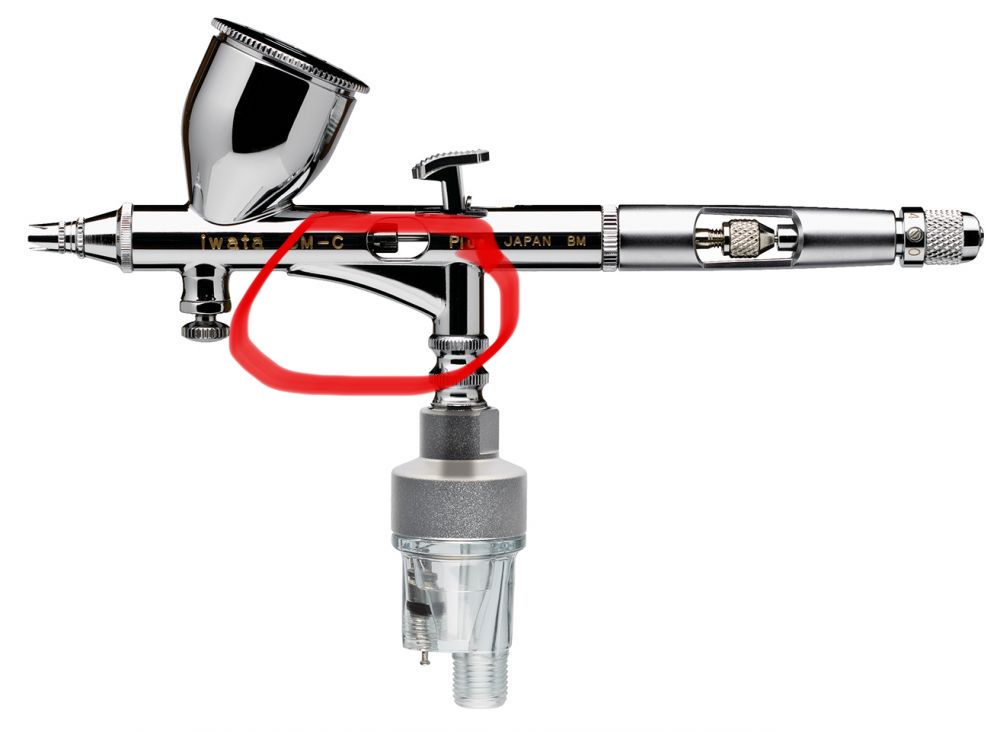Electric Cat Dude
Needle-chuck Ninja
It’s a common feature on most, but not all Japanese airbrushes. Maybe DaveG knows but what do you call this part? The hump?



I had known that those Japanese air brushes use that section as part of the air channel to the nozzle, I just wondered whether that part had a specific name, or there was a specific reason the Japanese manufacturers chose to create that feature whereas American and European Airbrush manufacturers did not.I have never heard a specific name for that particular piece... I have always thought of it as a thumb, or finger rest. As seen above, it is used as part of the air channel.
Fortunate that was one of those Chinese knock off air brushes. That would’ve been a very expensive item to take a waterjet cutter to otherwise!
I had known that those Japanese air brushes use that section as part of the air channel to the nozzle, I just wondered whether that part had a specific name, or there was a specific reason the Japanese manufacturers chose to create that feature whereas American and European Airbrush manufacturers did not.
I like it……..I like it……I call that part the taint, but I'm pretty sure that's not the technical term for it.
Taint quite the body of the brush...taint quite the air valve. It just is.
I'll accept my lashing now...
Of interest that feature varies a little bit in geometry depending on the airbrush. Some, like the HP-C have a very curvy shaped thingy whereas it’s more wedge shaped on brushes like the HP-SB or MP-200A. So there has to be some thought going into this. I wonder if it has to do with the size and balance of the brush in the hands which makes a designer choose one geometry over the other.I can only really speculate, as there does not seem to be much documentation to be found... 1st a general observation: it seems that in most regions, one design can be traced back to earliest production, and then others basically copied what was successful about it. You can see it in the American brushes, starting with the very earliest. You can look at either a very early Thayer Chandler Model A, or a Wold Model A-1 (largely designed by the same person). Everything else made in America since then can be traced right back to these brushes. Shoot, there are hardly a few differences between those, and what are being produced today, and mostly cosmetic at that. OK, so the Paasche Model V is a bit of a different build, but the key dimensions are actually identical to the other two - trigger distance from tip, and location of paint feed into the system - there is hardly a millimeter difference to be found between them all.
Same thing in Europe, particularly among the German brushes - many feature fixed double action triggers, similarly styled or shaped color cups, etc...
... and then the Japanese. These are perhaps even a bit more obvious, as there seems to be one common manufacturing facility for a good many of the available brands.
Now, on to the design - I really think that portion was added as a hand hold positioning aid, or comfort accessory to the design. Pretty sure it came about mid-50's to early 60's, so the basic airbrush design was already well established. There is no function advantage as far as air delivery to the head, and it would be more difficult to manufacture. Not only does the piece need to be formed, but the soldering also has to be done in such a way as to be air tight to avoid air leakage. Lots of hand fitting on this part, too - as hardly any two of them are actually the same. Once the factory was set up to produce the brushes this way, makes sense to just keep going.
Of interest that feature varies a little bit in geometry depending on the airbrush. Some, like the HP-C have a very curvy shaped thingy whereas it’s more wedge shaped on brushes like the HP-SB or MP-200A. So there has to be some thought going into this. I wonder if it has to do with the size and balance of the brush in the hands which makes a designer choose one geometry over the other.
Of interest that feature varies a little bit in geometry depending on the airbrush. Some, like the HP-C have a very curvy shaped thingy whereas it’s more wedge shaped on brushes like the HP-SB or MP-200A. So there has to be some thought going into this. I wonder if it has to do with the size and balance of the brush in the hands which makes a designer choose one geometry over the other.
